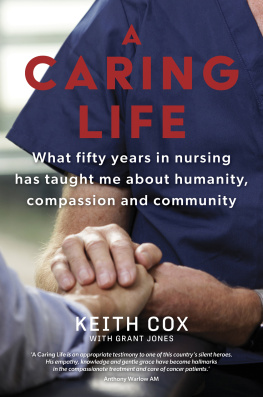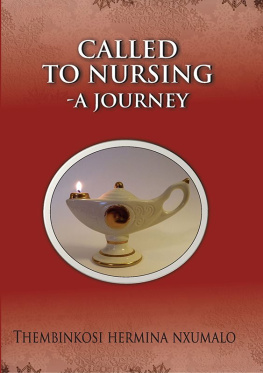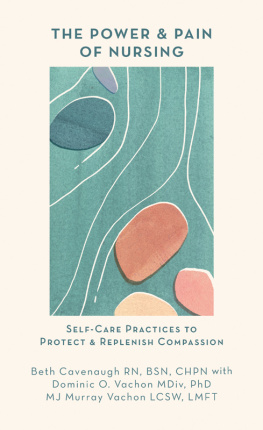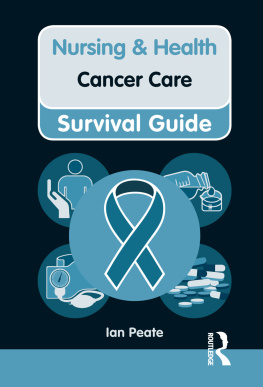About A Caring Life
As a nurse for nearly fifty years, Keith Cox provided expert care and comfort to countless people facing the unimaginable.
With insight and sensitivity, A Caring Life takes us behind the scenes of his remarkable nursing career and the moving stories of hope, determination and loss that underpinned it. Along the way, he shares lessons gained from a career spent confronting mortality, from finding joy in difficult circumstances to understanding that true strength comes in thinking of others and being part of a community.
Over the years, Keith has seen dramatic advances in medical treatment, as well as the limits of what medical intervention can achieve - which is why compassion and grace are his guiding principles, both on the ward and in his own life.
A Caring Life is the inspirational story of a nursing trailblazer who has learnt firsthand the value of human connection and kindness, in challenging times and in everyday life - and the satisfaction of living a life of service and meaning.

CONTENTS
This book is dedicated to the medical professionals who devote their lives to others, and to the families of those who have lost loved ones to cancer.
It must never be lost sight of what observation is for. It is not for the sake of piling up miscellaneous information or curious facts, but for the sake of saving life and increasing health and comfort.
Florence Nightingale (1859)
FOREWORD
When Keith and I first met in 1981, I was in my third year of medical school, which is the first time you see patients as a student training to be a doctor. By the early 1990s, when I began working as an oncologist, the causes of many cancers had been identified. However, cancer treatment then was still quite crude by todays standards. It was already clear that to treat cancer effectively an entire team was required, with physiotherapists and psychologists and, of course, highly competent and supportive nurses. Keith also knew that and thats how we started working together. He was one of those people who already understood the importance of teamwork and most important of all, the support patients needed, both emotional and physical, to get them through their cancer treatment.
It wasnt an accident either that there were similarities in the way we both wanted to treat patients, as we both knew treatment is driven by what you see and what you think is needed. Neither of us were satisfied with maintaining the status quo. If we thought there was a better way to do things, then we would work together on how we could do that and then implement change.
By the late 1980s, Keith had gained another reputation because he and a coterie of chemotherapy nurses dubbed KC and the Sunshine Band and later known as Keith and the Chemettes would parade through the wards administering cancer treatment. While Keith had a reputation for organising the serious stuff, such as cancer treatment, he was also renowned for organising all the parties and making the fun stuff happen as well, like car rallies and cocktail parties and cake-making competitions.
By 2006, much later in our careers, he asked me to help him be recognised as a nurse practitioner, which I thought was a fabulous idea. He knew that if he was able to do more of the things that needed doing, such as the prescribing and administering of cancer drug treatments, without having to wait for someone else including a doctor to come and do it, that our patients would benefit. To me, this is where the field of cancer treatment needed to go, so I fully endorsed it. To provide the very best care, specialist nurses with great expertise who know how to treat people are a key requirement.
When I took over from Professor Chris OBrien as Director of the Sydney Cancer Centre that same year, after Chris was diagnosed with brain cancer, Keith and I had very similar ideas about how we could execute his vision for a new state-of-the-art cancer treatment centre. A year after Chris died, the old Page Chest Pavilion at Royal Prince Alfred Hospital (RPA) was pulled down and Lifehouse was built. After it was completed, I thought: This is stuff that we had all talked about Chris, Keith and I all these ideas that we had worked on for many, many years are now a reality.
At the time, Keith was one of just three cancer nurse practitioners in Australia, so hes always been a bit of a ground-breaker and a pioneer for the cancer cause. Keith is also technically highly skilled and a competent nurse and I think you have to go a very, very long way to find a person with more compassion and care. The same compassion and care that he shows for patients, he also shows for colleagues. Plus he sets a very high standard of quality so its like he has all the good bits of being a perfectionist and none of the bad. That is one of his very good traits because, in health care, you want to get it right. If you dont get it right, bad things happen to people.
Keith has also long realised that there is always a better way to look after patients. His passion for nursing goes way beyond normal patient care. Its more than just feeling sorry for someone, though: its understanding what they are going through and knowing intuitively what he both as a nurse and a human being needs to do to help them through it. He doesnt feel like its his job or his duty either. He feels that its a privilege.
There would not have been too many days between 1993 (when I returned to RPA from overseas) and when Keith retired in 2018 that we havent spoken about a patient or I hadnt called him for advice. I know a lot of things but I dont know everything, and theres a bunch of things that he has in that vast bank of knowledge that I can tap into. While there are now other cancer nurse practitioners, its hard to find someone with 40 years of experience and who just has it in their bones, if you like. Someone who just gets it!
Michael Boyer AM
Chief Clinical Officer, Chris OBrien Lifehouse
1
NOT THE FIRST, NOT THE LAST
While I have travelled the world, lived overseas, met a future king, greeted premiers, consoled a prime minister, stood side by side with medical pioneers and met other famous people, I will always be a humble country boy at heart. My parents, Bill and Pansy Cox, married in the St Francis Xavier Catholic Church in Gunning, New South Wales, in 1934. Dad was a cabinet-maker by trade and grew up in Sydney, in St Peters. Mum, meanwhile, was from a farming family and her dad managed Boorowa, a property on the Southern Tablelands of NSW, while she worked as a cook and governess. Dad moved to the area and turned his trade to building houses, and later built St Silass Anglican Church, which still stands on the fringes of the bleached-blond hayfields of the Breadalbane Plain. After they met, fell in love and married, the young couple, with two kids in tow, bought a two-bedroom railway fettlers cottage at Cullerin, then a speck of a town between Goulburn and Gunning. This is where I was born.
They named their new home FayBri after their first-born girl, Fay, and first-born boy, Brian, but many more children were to come. After Fay was Coral, Dawn, then Brian, Ronnie and Judy. Mum had me when she was 38, Loretta at 41, and baby Vincent came along when Mum was 44. In the end, of the nine Cox children, only six of us were ever living at home at any one time because, as each new child was born, one of the older chickadees as Mum called us was ready to fly the nest.








